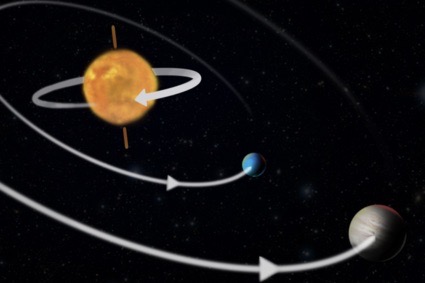News from SAC: Two exoplanets are orbiting backwards around a star
An international group of researchers, with the participation of Maria Hjorth, Ph.D.; Simon Albrecht, Ph.D.; and Ph.D. student Emil Knudstrup from the Center of Excellence SAC at Aarhus University, have discovered a special exoplanetary system with two exoplanets orbiting backwards around their star. The study has been published in the scientific journal Proceedings of the National Academy of Sciences (PNAS).

Three researchers from the DNRF’s Stellar Astrophysics Center (SAC) at Aarhus University are part of an international group of researchers that have discovered a special exoplanetary system with two exoplanets orbiting backwards around their star. The three researchers are Maria Hjorth, Ph.D., who led the study; Simon Albrecht, Ph.D.; and Ph.D. student Emil Knudstrup. The study has been published in the scientific journal Proceedings of the National Academy of Sciences.
“We found a very intriguing planetary system. There are two planets that orbit around the star in nearly the opposite direction as the star rotates around its own axis. This is unlike our own solar system, where all the planets are revolving in the same direction as the sun’s rotation,’’ said Hjorth, the first author of the study, which was recently published in the scientific journal PNAS.
Neighboring star tilts the disk
This isn’t the first known case of a backwards planetary system, but it differs from previous cases, as this time they seem to have found the reason behind it. Normally, a so-called protoplanetary disk, which is another word for a spinning, circular disk that swirls, and the star would spin the same way, but if there is a neighboring star, the gravitational force from the neighboring star might tilt the disk and thereby change its direction.
“I find our results encouraging as it means that we have found another aspect of system architecture where planetary systems show a fascinating variety of configurations. How would astronomy here on Earth have developed if the situation here had been similar to K2-290 — then Galileo would have seen sunspots moving in the opposite direction of the orbit of the Earth around the sun. One just wonders what his explanation would have been to that,” said Albrecht, co-author on the study.
The study was based on an international collaboration between researchers from SAC, the Tokyo Institute of Technology, the University of Toronto in Canada, and Pennsylvania State University in and Princeton University, both in the US.
Read more about the study from SAC at Aarhus University here
You can read the paper in Proceedings of the National Academy of Sciences here
